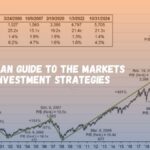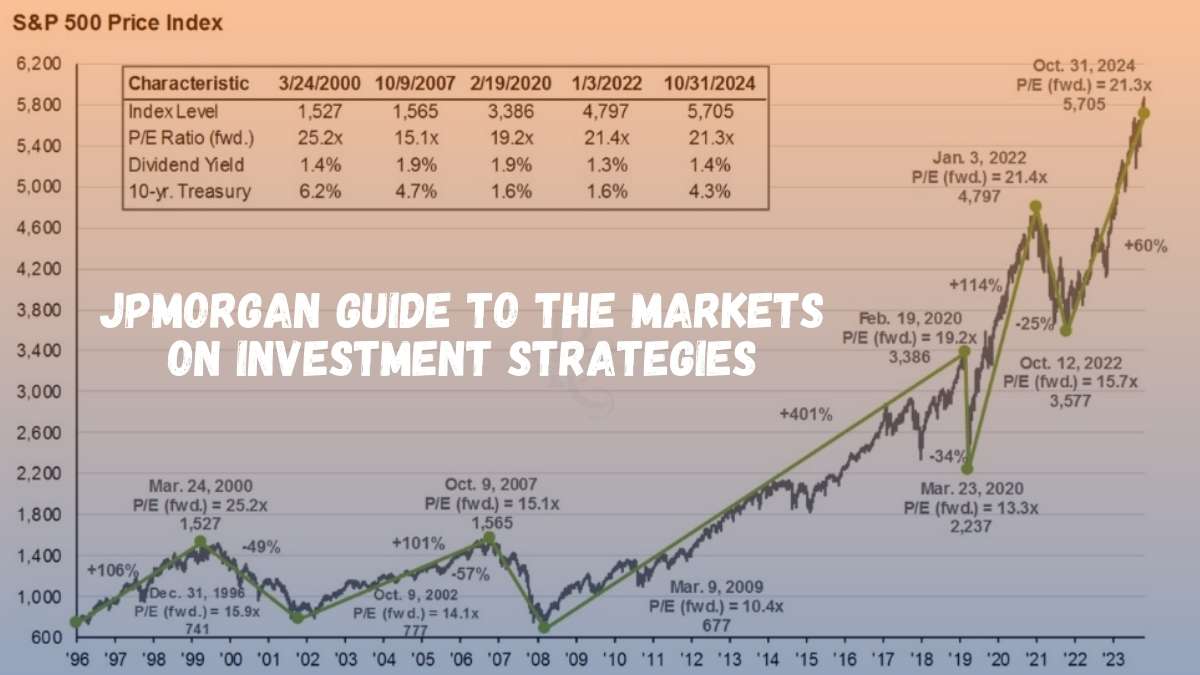In the sea of investments in which trends change as the tides and markets crash like waves, the requirement for an accurate and reliable guideline is vital. The JPMorgan guide to the markets is a must-read for financial advisors, investors, and market analysts who want to make educated decisions.
This guide isn’t only a map but rather an instrument that offers insights into the world economy, the strategies for asset allocation, and more. This article will review how you can use JPMorgan’s suggestions to improve the return on your investment.
Table of Contents
- Overview of JPMorgan’s Guide to the Markets
- Understanding the Global Economic Landscape
- Asset Allocation and Diversification Strategies
- Equity Market Insights
- Fixed Income and Interest Rate Trends
- Global Market Perspectives
- Inflation Protection and Real Assets
- Alternative Investments and Private Markets
- Economic Cycles and Investment Strategies
- Risk Management and Volatility Control
- Retirement and Long-Term Investment Strategies
- Impact of Technology and Innovation on Investments
- Sustainable and ESG Investing
- Portfolio Review and Adjustment Tips
- Utilizing JPMorgan’s Research and Tools
- Conclusion
Overview of JPMorgan Guide to the Markets
The JPMorgan guide to the markets offers a comprehensive overview of the current financial market, providing insight and an understanding founded on research. It is designed to assist investors in comprehending the most crucial investing strategies and gaining the maximum value from their portfolios.
Through studying the macroeconomic environment, market behavior, and investment opportunities, the guide reviews the market’s rapid growth. This guide is beneficial in determining how to allocate resources to reduce risk and increase yields accurately.
Understanding the Global Economic Landscape
It is a complex web of interconnected economic structures, each influencing the other. JPMorgan’s guide to investors helps them comprehend the world economy’s complexity by deconstructing regional economic reports and patterns regarding the rise in GDP and the impact of international trade.
Understanding these aspects can help investors predict market movements and adjust their strategies to changing trends. Understanding the complex nature of the world economy allows investors to identify areas that can benefit from growth or places that may be at risk due to economic or political instability.
Asset Allocation and Diversification Strategies
Asset allocation is the process of rollout investments across various classes of assets, which is the most important aspect of controlling risk and generating sustainability. This JPMorgan guide focuses on diversification to shield portfolios from threats from fluctuations.
By diversifying the portfolio of investments across equity, bonds, equity, and various other investment types, you can lessen the effect of poor performance in a particular segment. It also looks at new assets and urges investors to discover ways to diversify portfolios in the event of a shift in the market.
Equity Market Insights

Equity is a crucial component of a range of investments. It also can yield substantial gains. But they’re also vulnerable to market changes. The book by JPMorgan provides insight into the equity market by analyzing the performance of various segments and valuation indicators and trends.
Investors can utilize this knowledge to estimate the value of undervalued stocks, examine the general market mood, and make informed decisions about purchasing or selling. Being aware of the equity market is crucial to profit from growth opportunities while minimizing the risk.
Fixed Income and Interest Rate Trends
Fixed-income investments, like bonds and treasuries, favor stable earnings and instability. However, they are also affected by fluctuations in interest rates—JPMorgan’s guide on changes in interest rates and their effect on the fixed-income market. By better understanding these trends, investors can make educated decisions about their portfolios to adapt to fluctuations in interest rates.
Global Market Perspectives
The world’s markets are interconnected, which implies that the developments in a certain area could cause ripples worldwide. The JPMorgan guide to the markets provides an extensive overview of global markets by studying macroeconomic trends and geopolitical influences that impact the decision-making process.
Investors can gain from this information to adjust their strategies to the evolving global conditions regardless of whether they’re confronted with trade tensions, fluctuations in currencies, or changes to laws and rules. Global perspectives allow investors to profit from opportunities in the global market and reduce the risk of crossing borders.
Inflation Protection and Real Assets
Inflation can affect consumers’ buying capability, which can affect the return on investment. Real assets, such as commodities and real estate, can be a great source of protection against inflation due to their intrinsic value in addition to their physical properties.
JPMorgan’s guide explains the significance of real assets amid increasing prices. It also offers a glimpse into the types of assets that have historically performed well during times that are experiencing increased prices. By incorporating the real asset into your portfolio, you can protect yourself from inflation and improve your value.
Alternative Investments and Private Markets
Alternative investments such as biggest funds, personal equity, venture capital, and hedge funds are designed to prepare diversification over the traditional asset classes. JPMorgan’s Guide to alternative investments provides an overview of the advantages of alternative investments, including non-correlated returns and the potential to invest in opportunities that are not the same. However, they also have higher risk and lower liquidity. The guide provides an analysis framework for alternative investments.
Economic Cycles and Investment Strategies
Understanding the economic cycle of JPMorgan guide to the markets, the phases of expansion and contraction within the economy – can assist investors in devising strategies for investing. The guide from JPMorgan describes how different kinds of assets perform during various phases of the cycle of economics.
Investors can change their portfolios to benefit from the growth of expansions or ensure security during times that are experiencing expansion. By aligning their strategies for investing with the cycles driven by economic growth, investors can increase their portfolio’s value and decrease the risk.
Risk Management and Volatility Control
Risk management is one of the primary features of investing, especially in volatile markets. JPMorgan’s guidelines stress the importance of being aware of and lessening risk by diversifying your portfolio, allocating funds, and using hedge strategies. They also include ways to monitor portfolio performance and make adjustments to account for market volatility.
By taking proactive measures to mitigate risk, investors can safeguard their portfolios from the unpredictability of incidents and warrant that they are working steadily toward their financial objectives.
Retirement and Long-Term Investment Strategies
Retirement planning is a way to invest that balances security and growth. The guide from JPMorgan provides insight into creating pension portfolios. That offer the potential for cash flow streams and capital growth over time. It explains the significance of bonds, annuities, and stocks. When planning for retirement and ways to withdraw money with an eye toward the future. A well-planned retirement plan will help investors achieve confidence and financial security when they reach retirement age.
Impact of Technology and Innovation on Investments
Technological advances and innovations have transformed industries and provided numerous investment options. JPMorgan’s guide examines the ways that technology is impacting areas like finance, and energy. Healthcare and is focused on innovations like AI and automation, as well as green energy.
Investors can use this ultimate guide to study new trends, invest in new technologies, and prepare to grow in the coming years. Staying informed of changes in technology is crucial for gaining the long-term benefits.
Sustainable and ESG Investing
Environmental, social, and (ESG) aspects are becoming more important to investors who are looking for a sustainable return. JPMorgan’s guide offers an approach to incorporating ESG elements into investing strategies. It outlines the advantages of investing in sustainable investments, including less risk and better efficiency over time.
Investors can adapt their portfolios to their objectives while still working towards financial goals. Which can have positive environmental and social benefits.
Portfolio Review and Adjustment Tips
Reviewing your portfolio is important to verify it aligns with your investing goals and adapts to changes in market conditions. The guide from JPMorgan offers valuable tips for conducting effective portfolio reviews. Which include analyzing performance, rebalancing assets, and changing strategies.
A systematic method of managing portfolios ensures you are on the best track to complete your financial objectives regardless of the fluctuation that the market experiences.
Utilizing JPMorgan’s Research and Tools
JPMorgan offers a variety of tools and data to help make informed investment decisions. Everything from analysis platforms to market news can help investors stay similar to the developments to increase their investment portfolios.
Investors can benefit from JPMorgan’s experience by increasing their understanding of markets, creating strategies, and achieving higher returns. Using these sources is important to becoming a knowledgeable and successful investor.
Conclusion
In the world of financial markets, which is complex in which we live, a reliable and accurate guide could be of great help. The JPMorgan guide to the markets contain a wealth of data and strategies to assist investors, financial advisors, and market analysts achieve their goals.
By knowing the economy’s landscape, diversifying portfolios, and reducing risks, investors can meet their financial goals and be confident. Armed with the right information and tools, they can navigate the waters around them and benefit from opportunities that may lead to longevity and prosperity.
Frequently Asked Questions
Q1: What is the rule 606 for J.P. Morgan?
A: Rule 606 requires brokers to disclose details regarding the procedures they use to route orders to guarantee total transparency in their execution quality. This gives an understanding of how J.P. Morgan routes customer orders and the elements that influence the decisions that are made.
Q2: How do I get access to J.P. Morgan markets?
A: Access to the J.P. Morgan markets is usually provided through their brokerage service. Customers can sign up for an investment account to procure access to trading and financial services tools.
Q3: How do I withdraw money from my J.P. Morgan investment account?
A: To withdraw money from your J.P. Morgan investment account, Log into your account online or talk directly with your administrator. Follow the instructions for withdrawing the funds, and remember any processing charges or fees.










